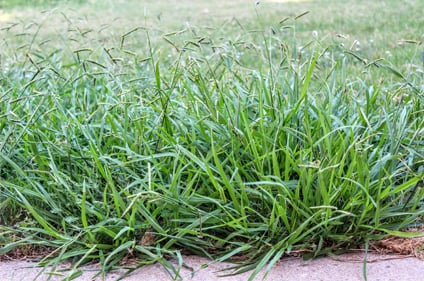On the other hand, mature and late-stage plants are somewhat easier to control, but it begs the question, Why?
Late season crabgrass is usually stunted and killed by frost, so applications at that time of the year may be wasteful. You are better off to just have some patience and wait it out until it disappears on its own.
Some of these products have multiple active ingredients and potentially some greater applications.
1. Dithiopyr – A commonly used pre-emergent herbicide, this product does also have some very early post-emergent activity. Typically, sprayable formulations tend to be a little more effective. Limitations come in that control is only up to the 1 tiller stage.
2. Quinclorac (Drive XLR8 or Quinclorac 75 DF and 1.5L) – This product is typically very effective on 1 tiller or smaller and 4 tiller or larger. This product can be applied to most cool and warm season grasses, and as always make sure to consult the label. There are a few definite upsides. Drive will control several other grassy and broadleaf weeds, and at full rate will provide up to 45 days of residual pre-emergent crabgrass control. Make sure to mix with a methylated seed oil (MSO) surfactant. May be mixed with some other post- and pre-emergents.
3. Mesotrione (Tenacity) – Tenacity can get very good control up to the 4 tiller stage but may take two applications at two-week intervals. Be advised, this product will turn weeds white. Tenacity also gets good control of 40 – 50 other grassy and broadleaf weeds and provides some pre-emergent protection. Apply with a nonionic surfactant (NIS) and make certain to pay attention to desirable grass species to reduce non-target injury. Can be applied at the time of seeding with many turfgrass species to reduce competition from weeds.
4. Topramazone (Pylex) – Pylex is similar in activity to that of Tenacity (especially the whitening effect) but has very little use on warm season grasses with the exception of centipedegrass, which it will damage. Pylex may require reapplication in two to three weeks if applied alone or can be mixed with Drive XLR8 for more complete control. Pylex should be applied with an MSO. Can be mixed with some other post and pre-emergent herbicides. It is also strong on goosegrass.
5. Fenoxaprop – One of the primary components of Last Call, this product is also formulated with Fluroxypyr and Dicamba for broad spectrum activity. Fenoxaprop is very good on later stages of crabgrass up to 5 tillers. Primarily just for use on cool season grasses, it will also get control of goosegrass and suppress Bermuda grass. Do not mix with 2,4-D or apply in the window before or after.
6. Combination products – Q4 Plus, 2DQ, and Solitaire all contain quinclorac. Q4 Plus offers the broadest spectrum of weeds controlled and may be the best choice for a late season clean up application.
There are a few other ideas to keep in mind. Like other post-emergent herbicides, weeds must be actively growing and not under stress. As a matter of fact, watering up to two days prior to application can greatly enhance results. Also, never apply herbicides over 85 F as the risk of injury to desirable turfgrasses greatly increases. Encourage a healthy, thick stand of turf to reduce crabgrass germination and help crowd out the plants that do arise.
Visit the PennState Extension website for good photos of crabgrass life stages. Always read and follow all label instructions!
Contact the Ewing Technical Services Team with any questions.




